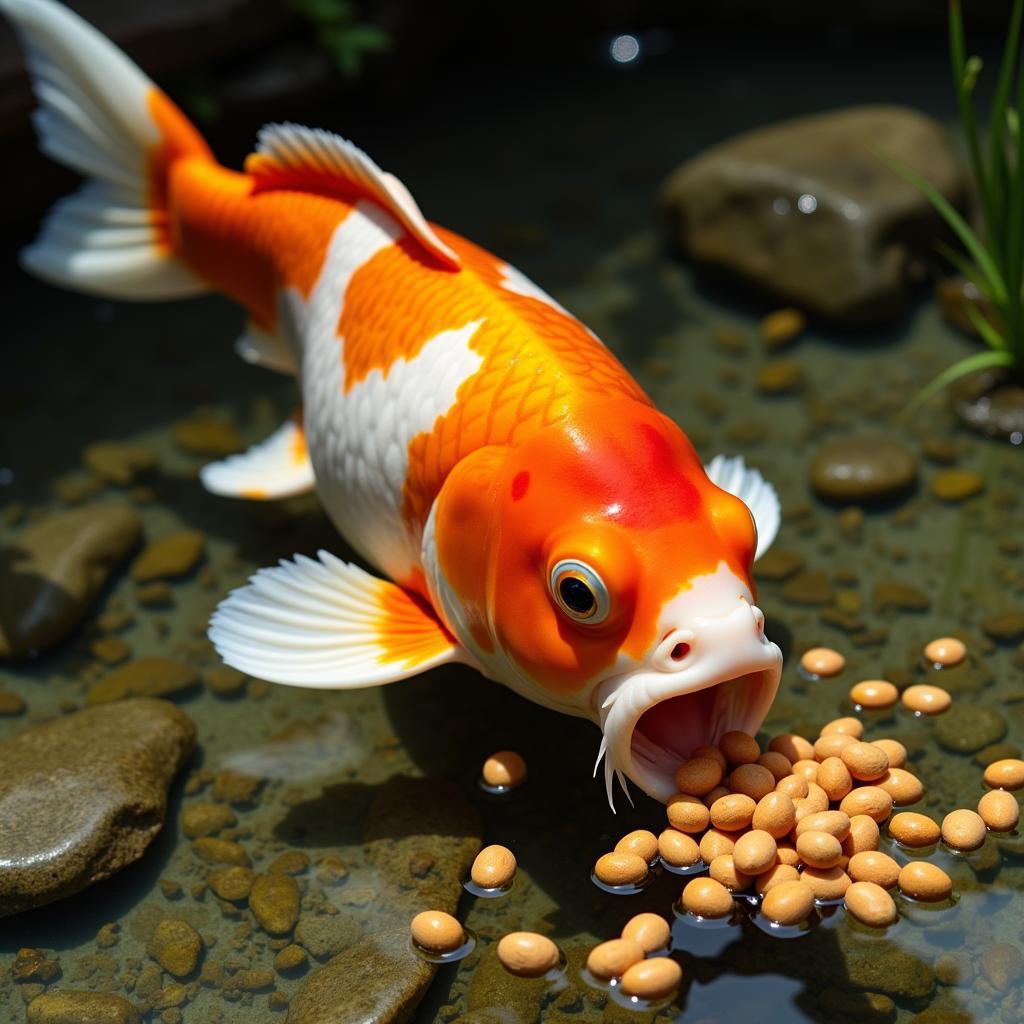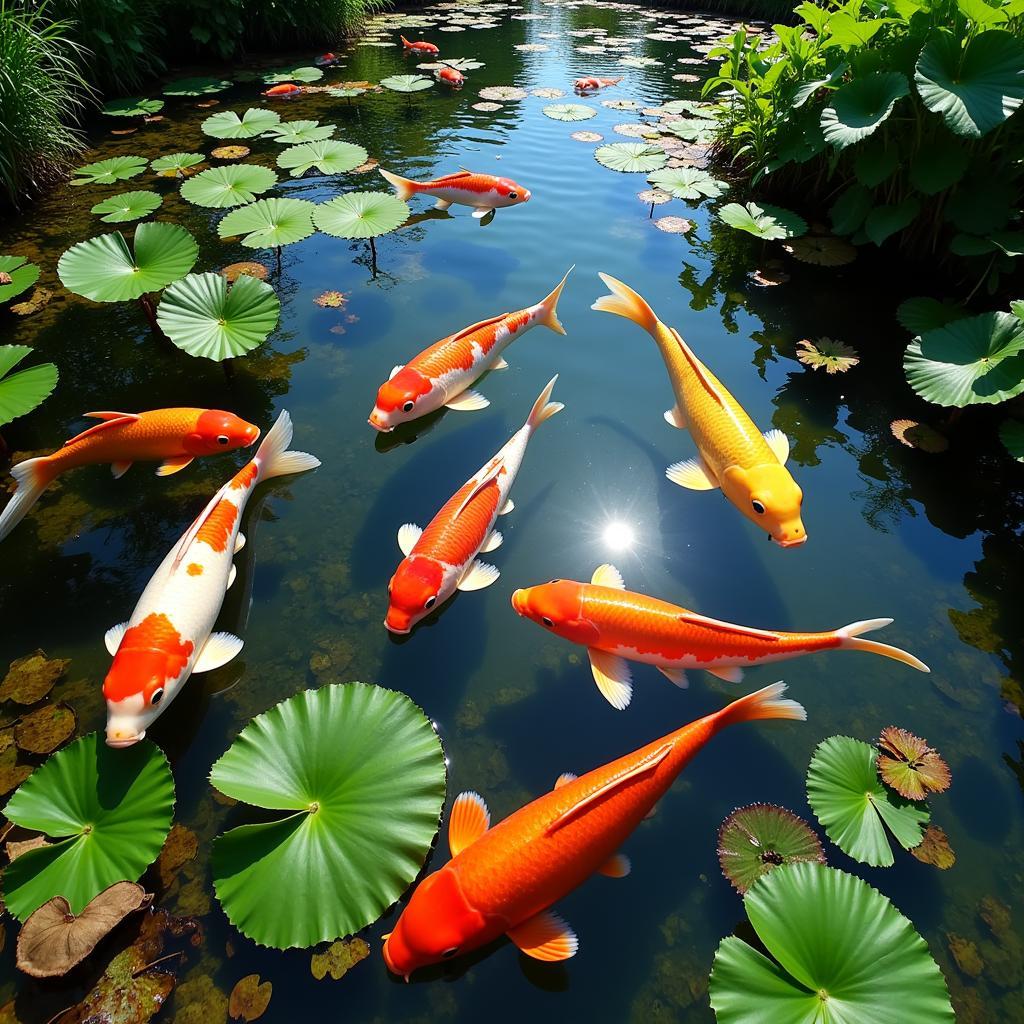Koi carp are more than just fish; they’re living jewels, shimmering beneath the surface of your pond. Their vibrant colors and graceful movements bring a sense of tranquility and beauty to any outdoor space. But to keep these jewels sparkling, you need to provide them with the Best Koi Carp Food. This guide will delve into everything you need to know about selecting the perfect diet for your finned friends.
Choosing the right koi best food can significantly impact your koi’s health, growth, and color vibrancy. From understanding the nutritional needs of koi at different life stages to deciphering ingredient lists and navigating the various types of food available, this comprehensive guide will equip you with the knowledge to make informed decisions. We’ll explore the importance of protein, carbohydrates, fats, vitamins, and minerals, and how a balanced diet can boost their immune system and enhance their natural brilliance.
Decoding Koi Nutrition: What Makes the Best Koi Carp Food?
Just like us, koi require a balanced diet to thrive. This means providing them with the right proportions of proteins, carbohydrates, fats, vitamins, and minerals. Protein is crucial for growth and muscle development, especially in young koi. Carbohydrates provide energy, while fats are essential for maintaining cell health and providing a reserve energy source. Vitamins and minerals are vital for overall health and immune function. The best koi carp food will have a balanced blend of all these nutrients.
Protein Power: Fueling Growth and Vitality
Protein is the building block of life, and it’s particularly important for young, growing koi. Look for koi food with high-quality protein sources, such as fish meal, krill meal, and insect meal. These provide the essential amino acids that koi need to develop strong muscles and vibrant scales.
 Koi Carp Eating High-Protein Food
Koi Carp Eating High-Protein Food
Carbohydrates: The Energy Source for Active Koi
Carbohydrates are the primary energy source for koi, fueling their activity and keeping them swimming strong. While carbohydrates are important, too many can lead to digestive issues. Look for koi food that uses digestible carbohydrates like wheat germ and rice bran.
Essential Fats: Maintaining Health and Vibrancy
Fats are crucial for cell health and provide a reserve energy source for koi. They also contribute to the vibrant colors of your koi. Look for food that contains omega-3 and omega-6 fatty acids, which are beneficial for overall health and color enhancement.
 Healthy Koi Carp with Vibrant Colors
Healthy Koi Carp with Vibrant Colors
Choosing the Right Food for Different Seasons and Life Stages
The best koi carp food isn’t a one-size-fits-all solution. Different life stages and seasons require different nutritional profiles. Young koi need more protein for growth, while mature koi require a diet that supports their overall health and maintains their vibrant colors. During colder months, koi need less food, and the food should have a lower protein content. In warmer months, when koi are more active, they require a higher protein diet.
Tailoring Your Koi’s Diet: Seasonal Considerations
Just like us, koi’s appetites change with the seasons. In the warmer months, they are more active and require a higher protein diet to fuel their energy levels. During colder months, their metabolism slows down, and a lower protein diet is more appropriate.
“Seasonal feeding is crucial for koi health,” explains Dr. Emily Carter, a leading aquatic veterinarian. “Adjusting the type and amount of food according to the water temperature helps prevent digestive problems and ensures optimal nutrient absorption.”
Types of Koi Food: From Pellets to Treats
Koi food comes in a variety of forms, including pellets, flakes, sticks, and even freeze-dried treats. Pellets are the most common and generally offer the most balanced nutrition. Hikari koi food is a popular brand known for its high-quality ingredients and balanced nutrition. Flakes are a good option for smaller koi or as a supplemental food. Sticks can be a fun and engaging way to feed your koi, while freeze-dried treats should be given sparingly.
Reading the Label: Understanding Ingredients and Quality
Knowing how to read a koi food label is essential for choosing the best diet. Look for ingredients that are easily digestible and provide the necessary nutrients. Avoid fillers and artificial colors or flavors. Pond fish food 50 lb can be a cost-effective option, but it’s crucial to check the ingredients to ensure quality.
 Different Types of Koi Carp Food
Different Types of Koi Carp Food
Conclusion: Investing in the Best Koi Carp Food for a Thriving Pond
Choosing the best koi carp food is an investment in the health and beauty of your pond. By understanding their nutritional needs, considering the seasons, and selecting high-quality food, you can ensure that your koi thrive and continue to bring joy and tranquility to your outdoor space.
FAQ
- What is the best food for koi carp growth?
- How often should I feed my koi?
- What type of food should I feed my koi in winter?
- Can I feed my koi treats?
- How can I tell if my koi food is good quality?
- What are the signs of a malnourished koi?
- How can I improve the color of my koi?
For further assistance, please contact us at Phone Number: 02437655121, Email: minacones@gmail.com Or visit our address: 3PGH+8R9, ĐT70A, thôn Trung, Bắc Từ Liêm, Hà Nội, Việt Nam. We have a 24/7 customer service team.